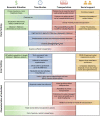Barriers and Facilitators to Ophthalmology Visit Adherence in an Urban Hospital Setting
- PMID: 37831446
- PMCID: PMC10587857
- DOI: 10.1167/tvst.12.10.11
Barriers and Facilitators to Ophthalmology Visit Adherence in an Urban Hospital Setting
Abstract
Purpose: To explore barriers and facilitators to completing scheduled outpatient appointments at an urban academic hospital-based ophthalmology department.
Methods: Potential participants were stratified by neighborhood Social Vulnerability Index (SVI) (range, 0-1.0, higher scores indicate greater vulnerability), and semistructured interviews were conducted with individuals 18 years and older with an SVI of greater than 0.61 (n = 17) and providers delivering care in the General Eye Clinic of the University of Illinois Chicago (n = 8). Qualitative analysis informed by human-centered design methods was conducted to classify barriers and facilitators into three domains of the Consolidated Framework for Implementation Research: outer setting, inner setting, and characteristics of individuals.
Results: There were four main themes-transportation, time burden, social support, and economic situation-all of which were within the outer setting of the Consolidated Framework for Implementation Research; transportation was most salient. Although providers perceived health literacy as a barrier affecting motivation, patients expressed a high motivation to attend visits and felt well-educated about their condition.
Conclusions: A lack of resources outside of the health system presents significant barriers for patients from neighborhoods with high SVI. Future efforts to improve adherence should focus on resource-related interventions in the outer setting. Improving access to eye care will require community-level interventions, particularly transportation.
Translational relevance: Understanding the barriers and facilitators within the Consolidated Framework for Implementation Research provides useful guidance for future interventions, specifically to focus future efforts to improve adherence on resource-related interventions.
Conflict of interest statement
Disclosure:
Figures
Similar articles
-
Evaluating the Relationship between Neighborhood-Level Social Vulnerability and Patient Adherence to Ophthalmology Appointments.Ophthalmic Epidemiol. 2024 Feb;31(1):11-20. doi: 10.1080/09286586.2023.2180806. Epub 2023 Feb 23. Ophthalmic Epidemiol. 2024. PMID: 36820490 Free PMC article.
-
Provider Barriers and Facilitators of Breast Cancer Guideline-Concordant Therapy Delivery in Botswana: A Consolidated Framework for Implementation Research Analysis.Oncologist. 2021 Dec;26(12):e2200-e2208. doi: 10.1002/onco.13935. Epub 2021 Sep 2. Oncologist. 2021. PMID: 34390287 Free PMC article.
-
Implementation challenges in delivering team-based care ('TEAMcare') for patients with chronic obstructive pulmonary disease in a public hospital setting: a mixed methods approach.BMC Health Serv Res. 2016 Aug 3;16(a):347. doi: 10.1186/s12913-016-1592-2. BMC Health Serv Res. 2016. PMID: 27488412 Free PMC article.
-
Implementation of e-Mental Health Interventions for Informal Caregivers of Adults With Chronic Diseases: Mixed Methods Systematic Review With a Qualitative Comparative Analysis and Thematic Synthesis.JMIR Ment Health. 2022 Nov 30;9(11):e41891. doi: 10.2196/41891. JMIR Ment Health. 2022. PMID: 36314782 Free PMC article. Review.
-
Communication partner training with familiar partners of people with aphasia: A systematic review and synthesis of barriers and facilitators to implementation.Int J Lang Commun Disord. 2023 Mar;58(2):601-628. doi: 10.1111/1460-6984.12805. Epub 2022 Nov 23. Int J Lang Commun Disord. 2023. PMID: 36417196
Cited by
-
Ophthalmic Care at an Academic Medical Centre for Patients who were Incarcerated or in Immigration Detention.Res Sq [Preprint]. 2025 Apr 21:rs.3.rs-6050144. doi: 10.21203/rs.3.rs-6050144/v1. Res Sq. 2025. PMID: 40313751 Free PMC article. Preprint.
References
-
- National Academies of Sciences E, Medicine, Health et al. The National Academies Collection: reports funded by National Institutes of Health. In: Welp A, Woodbury RB, McCoy MA, Teutsch SM, eds. Making eye health a population health imperative: vision for tomorrow. Washinton, DC: National Academies Press. Copyright 2016 by the National Academy of Sciences. All rights reserved; 2016. - PubMed
MeSH terms
Grants and funding
LinkOut - more resources
Full Text Sources


